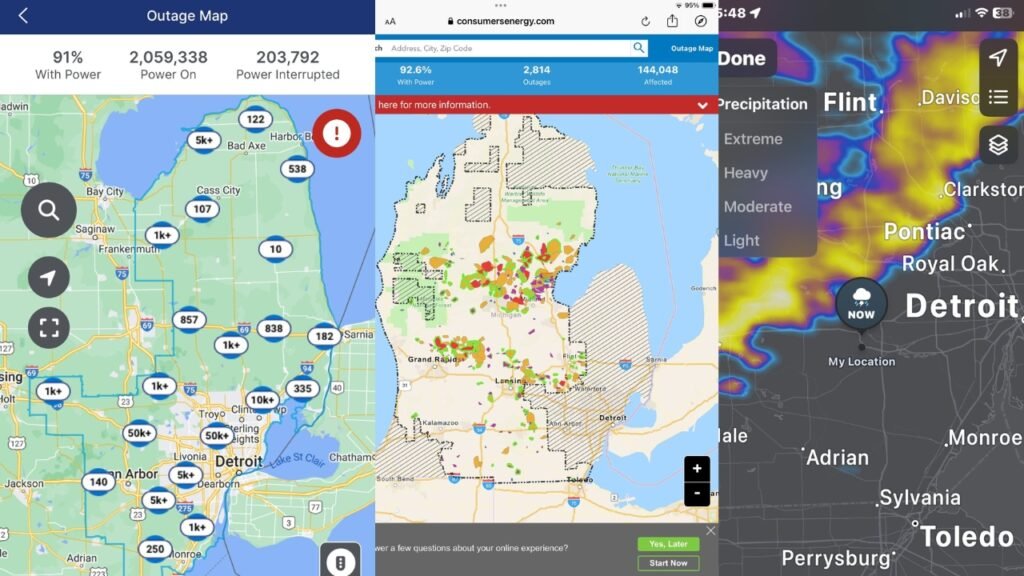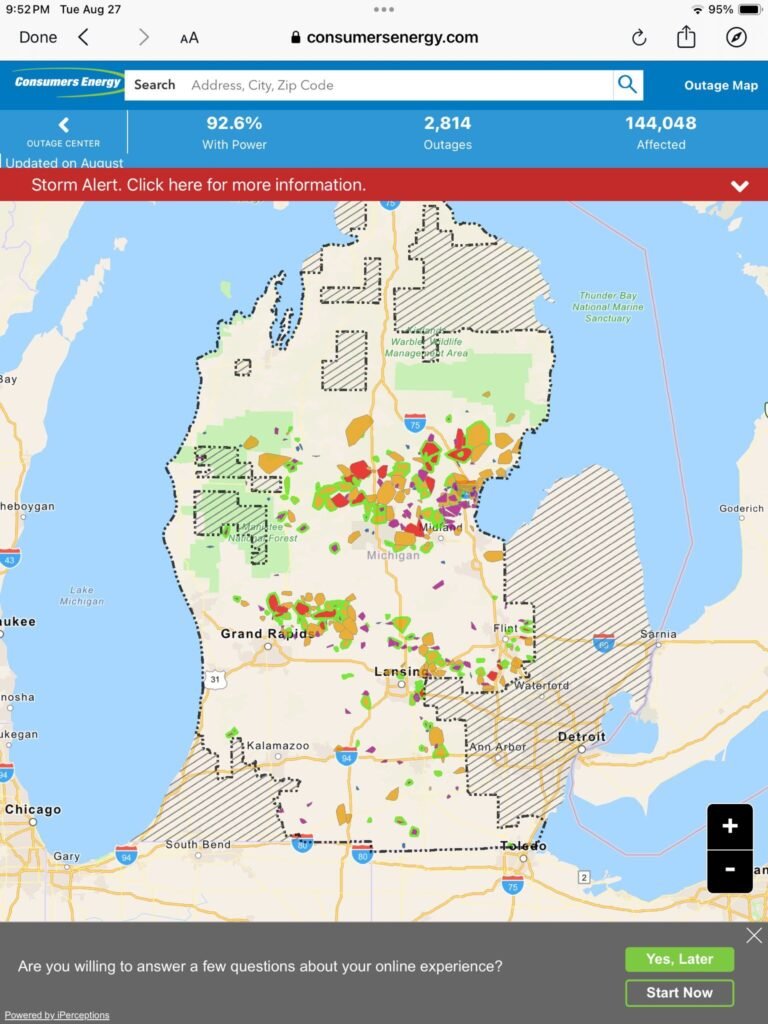Climate Warning: Michigan’s Heatwave And Thunderstorms Signal Urgent Action
- Leave a Comment
- James M
- August 28, 2024

On Tuesday, Michigan saw a sharp change in the weather as the state was hit by a terrible mix of intense heat and strong thunderstorms.
The uncomfortable climate that resulted from the skyrocketing temperatures, which saw heat indices rise to an astounding 100 degrees, put a burden on both infrastructure and citizens.
The day’s difficulties were made worse by the strong thunderstorms that quickly followed the tremendous heat. These storms brought with them torrential rain, violent gusts, and even tornado warnings.
The effects on the locals were profound and immediate. Over 365,000 households and businesses were impacted by power outages, which left many of them without basic utilities and plunged many into darkness.
All around the state, rescheduled classes and school closures were instituted due to the extreme temperatures.
Grocery stores and neighborhood associations were among the businesses that were forced to close, upsetting regular routines and making it more difficult to stay cool and safe.
As the severe weather continued, health hazards became a big worry. Stormy weather combined with high temperatures increased the risk of heat-related disorders such heat exhaustion and heat stroke.
The risk to vulnerable populations, including the elderly and those with pre-existing health concerns, was particularly high because power disruptions left many without air conditioning.
The catastrophic weather on this particular day not only put Michigan’s infrastructure to the test but also highlighted how urgent it is to address the wider effects of climate change.

The Heatwave: An Increasing Fear
A relentless heatwave swept across Michigan on Tuesday, bringing oppressive temperatures and a scorching 100 degrees for the heat index. The oppressive heat made it feel less like a summer day and more like a furnace.
Residents found it difficult to find relief due to the combination of high temperatures and unbearable humidity because even covered spots provided little reprieve from the intense heat.
There are serious and varied health dangers connected to this intense heat. Heat exhaustion, which manifests as excessive perspiration, weakness, lightheadedness, and nausea, can worsen into heat stroke, a potentially fatal illness that is characterized by a dangerously elevated body temperature, disorientation, and even unconsciousness.
People need to stay cool and hydrated since the body loses fluids more quickly and dehydration becomes a serious worry.
The dangers are especially higher for vulnerable groups, such as the elderly, small children, and people with chronic illnesses, underscoring the critical need of taking precautionary action during heatwaves.
Beyond just posing health risks, the heatwave caused disruptions to everyday life in Michigan. Due to a lack of air conditioning, many schools were compelled to close or change their timetables in order to protect pupils from the excessive heat.
This had a cascading effect, causing many working people to experience unforeseen disruptions and parents to scramble to locate other daycare options.
In addition, many residences lacked air conditioning, which meant that many individuals had nowhere to go to escape the heat, making matters worse for those who were already finding it difficult to cope with the rising temperatures.
This heatwave is a part of a larger trend that is being fueled by climate change rather than an isolated occurrence. Extreme heat events are growing more common and intense as global temperatures rise, putting additional strain on infrastructure and populations.
It is imperative that society adjust and put policies in place to lessen the effects of rising temperatures because heatwave intensity is predicted to increase over the next several decades.
The tragic events that occurred in Michigan serve as a clear reminder of how vital it is to combat climate change and get ready for the increasingly common extreme weather occurrences.
My Dad, earlier tonight: "We lost power for a bit but, kinda expect that"
— Jen (@jenelaina) August 28, 2024
8.7% of DTE customers right now. This shouldn't BE our expected. I'm preaching to the choir but worth remembering how much they absolutely, comparatively, objectively suck.
➡️ https://t.co/DDXLhgyeJS pic.twitter.com/Sa9Q4IOGLD
Tornado Warnings and Power Outages During Violent Storms
As the day went on, the stifling heat in Michigan gave way to a barrage of intense thunderstorms that tore through the state.
A scorching heatwave that had started quickly turned into a turbulent afternoon with thunderstorms bringing strong winds, a lot of rain, and the possibility of tornadoes.
The sudden change from heat to intense storms produced a chaotic atmosphere that made the problems locals faced even more difficult.
Over 365,000 households and businesses in Michigan experienced power outages as a result of the thunderstorms, which created serious disruptions.
Nearly 143,000 customers in northern Michigan and the Grand Rapids region lost power, according to Consumers Energy, while approximately 224,000 customers in southeast Michigan were affected by DTE Energy’s outage.
Utility providers moved quickly to hasten restoration efforts, mobilizing hundreds of additional service members from outside the area.
Despite their best efforts, many residents were left in the dark and had to deal with the additional difficulties of not having electricity during a strong storm due to the sheer magnitude of the outages.
The disruption of companies and key services caused by power outages has a significant impact on day-to-day living. The closure of grocery stores and other businesses caused a disruption in the availability of essential supplies and services.
Intersections without working traffic lights made for dangerous driving conditions, increasing the chance of accidents in already challenging driving circumstances.
Because of the commotion, emergency personnel had an even harder time responding to calls for aid, which further jeopardized public safety.
All day long, there were tornado warnings, which increased the severity of the situation. The violent storms increased inhabitants’ sense of urgency and fear by triggering alarms for potential tornado activity.
The mix of strong storms and the potential for tornadoes highlighted the event’s seriousness, highlighting the weather’s potent and erratic characteristics as well as its extensive effects on Michigan’s communities.
🚨🇺🇸Major severe storms passed through parts of Michigan a few hours ago DTE power outages over 300 K ⚠️
— Todd Paron🇺🇸🇬🇷🎧👽 (@tparon) August 28, 2024
Channel 7 News Detroit loses power can’t show Maps or graphics of the storm⚡️pic.twitter.com/82A5WcQo05
The extreme weather that hit Michigan on Tuesday is a clear illustration of how climate change is increasingly affecting the weather patterns on our globe.
This is not a single incidence; rather, it is a reflection of the growing frequency and severity of extreme weather events brought on by global climate change.
Extreme heat and strong thunderstorms. More moisture and energy can be retained in the atmosphere as the planet heats, resulting in more extreme and erratic weather.
The occurrence of extreme weather events has been increasing globally, with occurrences of strong storms, prolonged heatwaves, and heavy rainfall becoming more frequent.
This increasing tendency is part of a larger pattern wherein rising temperatures and changing weather patterns increase the probability of these kinds of catastrophic events.
The effects are felt all throughout the world, with certain areas facing unheard-of weather that poses problems for daily living and infrastructure.
There are substantial effects of climate change on the environment and public health as well. People are subjected to more frequent and intense heatwaves as a result of rising global temperatures, which increases the number of heat-related deaths.
Severe heat can make pre-existing medical issues worse and put a pressure on the medical system.
Furthermore, because of drier weather and rising temperatures, wildfires are occurring more frequently. Climate change also has an adverse effect on air quality, which worsens respiratory health.
Data from statistics highlights how serious the situation is. The number of heat-related mortality in the United States has increased dramatically in recent years; 1,602 deaths were reported in 2021, 1,722 in 2022, and 2,302 in 2023.
These figures show an alarming rising trend that is probably going to continue as catastrophic weather events become more frequent.
It is critical to address and mitigate the effects of climate change in order to safeguard public health and improve resilience to extreme weather, as climate models forecast more intense heatwaves and severe weather in the future.

Recognizing and responding to the growing threat of climate change is crucial as extreme weather events become more frequent and severe.
The recent events in Michigan highlight the urgent need for comprehensive strategies to address and mitigate the impacts of a changing climate.
It is imperative for both individuals and governments to take proactive measures to reduce greenhouse gas emissions and build resilience against extreme weather.
Making investments in resilient infrastructure is one of the most important measures in reducing the effects of extreme weather.
This include creating structures that can withstand extreme weather and greater temperatures, as well as enhancing drainage systems to prevent flooding and electrical grid upgrades to withstand storms.
These investments save lives and resources by strengthening community resilience and lessening the financial impact of weather-related disruptions.
Another crucial step is to guarantee disadvantaged populations have access to cooling centers and supplies. Cooling centers offer secure locations for people without air conditioning to get away from extremely hot weather during heatwaves.
To make sure that everyone in the community, especially the elderly and those with pre-existing medical conditions, can utilize these resources when needed, it is imperative that these facilities be expanded and that outreach be strengthened.
During periods of extreme weather, community programs and public health campaigns can also be quite effective in increasing awareness and offering assistance.
In order to combat climate change, both local and global action are needed. International accords, like the Paris Agreement, seek to restrict the increase in global temperatures and motivate nations to implement climate-friendly measures.
Communities can encourage sustainable development, adopt green practices, and push for laws that lower carbon emissions at the local level.
To make a real difference and create a future that is more robust to climate change, governments, corporations, and individuals must work together.
Conclusion:
The intense heat and strong thunderstorms that typified this week’s catastrophic weather that swept across Michigan have had a significant effect on the state.
The impacts of this weather phenomenon have been immediate and extensive, with over 365,000 households and businesses without electricity, substantial disruptions to daily life, and serious health hazards due to the extreme heat.
Heatwaves and powerful storms together provide as a clear warning of the intensifying weather patterns associated with climate change.
It’s more important than ever to be aware of the weather and to be ready for extremes. The probability of experiencing extreme weather events increases when climatic patterns persist in their transformation.
People must take proactive measures to safeguard their health and safety under extreme weather conditions, including recognizing weather warnings and preparing for power disruptions.
Additionally, communities and local governments are essential in supplying resources and information to enable citizens to successfully traverse these difficulties.
Together, all facets of society must make a concentrated effort to address the problems caused by climate change. To lessen the effects of harsh weather and increase resistance to it in the future, community action is required.
This entails making investments in climate change-fighting legislation, encouraging community readiness, and building resilient infrastructure.
We can better protect vulnerable populations, our communities, and our future stability and security in the face of climate change by banding together and acting decisively.
